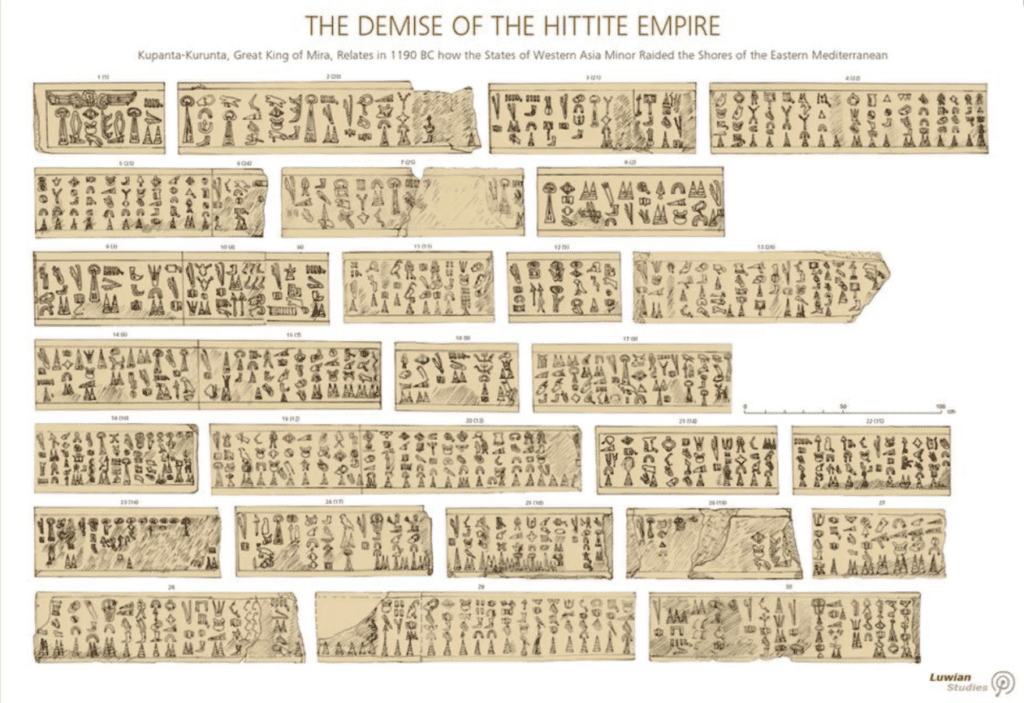
A mysterious ancient inscription that has eluded scholars for over a century has finally been deciphered. The 3,200-year-old stone is etched in a forgotten language called Luwian, which fewer than two dozen people understand. Fred Woudhuizen, an independent scholar, claims he has now deciphered the meaning of the long and elaborate inscription, which tells the story of a prince named Muksus from Troy, his military exploits, and mentions the Sea People confederation. There are critics, however, who are skeptical of the inscription’s authenticity.
The story of a Trojan war bellowed in a forgotten language
According to Woudhuizen and Eberhard Zangger, a geoarchaeologist who is president of the Luwian Studies foundation, the ancient inscription sheds light on a rather lesser known period in antiquity. It mentions a confederacy of maritime warriors which scholars refer to as the Sea People and who wreaked havoc on the Mediterranean. They harried the coastal towns and cities of the Mediterranean region between c. 1276-1178 BCE, concentrating their efforts especially on Egypt. “They came from the sea in their warships,” reads one ancient inscription, unrelated to the Luwian writings, “and none could stand against them.”
Now the northern countries which were in their islands were quivering in their bodies. They penetrated the channels of the river mouths [the Nile Delta]. They struggle for breath, their nostrils cease. His Majesty is gone out like a whirlwind against them fighting on the battlefield like a runner, the dread of him and the terror have entered their bodies, they are capsized and overwhelmed where they are. Their heart is taken away and their soul is flown away, their weapons are scattered upon the sea.
Sea Peoples’ inscriptions in Medinet Habu dating to the time of Ramesses III (Breasted).
Outside Egypt, they also assaulted the regions of the Hittite Empire, the Levant, and other areas around the Mediterranean coast. The new translation indeed supports these records, as it paints the story of a kingdom called Mira, located in what’s now western Turkey, and how it raided the Middle East, destroying the Hittite Empire in the process, along with other kingdoms.
The copy of the stones dated to 3,200 years ago mentions how King Kupantakuruntas became the ruler of Mila. The story begins with his father, King Mashuitta, who took control of Troy after its king named Walmus was overthrown. Not long after, Mashuitta reinstated Walmus on Troy’s throne in exchange for his unconditional loyalty. After his father died, Kupantakuruntas became ruler of Mira and ‘guardian of Troy’. In the inscription, Kupantakuruntas urges his successors to “guard Wilusa [an ancient name for Troy] (like) the great king (of) Mira (did).” The same stone inscription details how Trojan prince Muksus led a naval expedition that eventually conquered Ashkelon, located in modern-day Israel, and how a fortress was erected there.
Another story in itself
The inscription etched on 95-feet-long stone (29 meters) was supposedly discovered in Turkey in the 19th century but was subsequently destroyed, its bits stolen and used by locals to build their homes. James Mellaart, a famous archaeologist who discovered several ancient sites, including Çatalhöyük, a 9,500-year-old settlement in Turkey that some claim is the oldest city in the world, luckily retained a copy of the inscription in his possession. The archaeologist died in 2012, but left instructions saying that if the inscription couldn’t be deciphered during his lifetime, other scholars are more than welcome to try.
Mellaart’s notes suggest that the stone writings were copied in 1878 by archeologist Georges Perrot near a village called Beyköy in Turkey. After the stones were broken into bits and used as construction material for homes and a mosque, Turkish authorities searched the village and found three bronze tablets that are now missing. We don’t know what they said, unfortunately. It’s just that there’s a record that at some point these bronze tablets were found, so we can only presume a relation with the ancient Luwian writings.
According to the late archaeologist’s notes, Mellaart began work to decipher the massive stone inscriptions in 1956, along with other archeologists and linguists. Allegedly, the team couldn’t publish anything before most of the team members died. Mellaart, who died at age 86, outlived them all and reportedly dedicated his last years to understanding the copies of the Luwian writings. However, he was unsuccessful. Mellaart was not a linguist and was included in the team for his expertise in western Turkey archaeological landscape.
Live Science reports that some scholars unaffiliated with the present research have expressed doubt over the authenticity of these ‘copies’. Some have accused Mellaart of purposely spreading a modern forgery, and since no physical records of the inscription have been found, we can never be sure all of these writings are authentic.
Zangger and Woudhuizen say that right now there’s no way to tell for certain if the inscriptions were authentic. Nevertheless, it would have been extremely difficult for Mellaart to pull off a forgery of this caliber. The two say that Luwian was barely deciphered for the first time in the 1950s. Few know how to read it, let alone make a very vivid and detailed backstory in Luwian. There’s also the question of motive. Why would Mellaart go to such lengths to construct such a complex forgery but fail to publish anything?
The findings will be published in an upcoming December edition of the Proceedings of the Dutch Archaeological and Historical Society.



